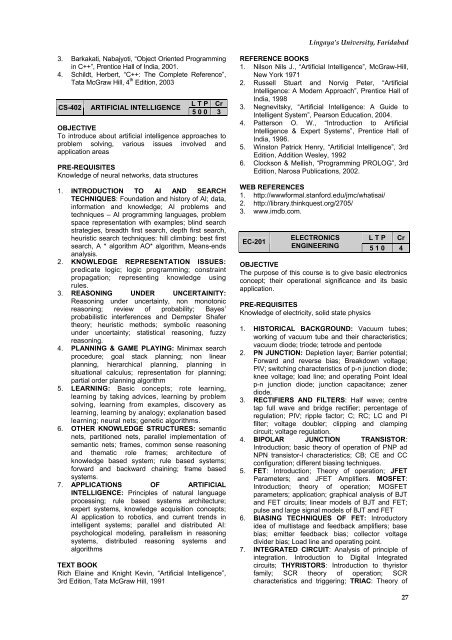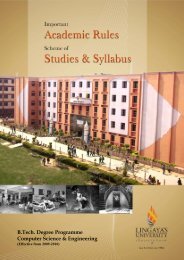B.<strong>Tech</strong>. <strong>Electrical</strong> <strong>Engineering</strong> (Regular)CS-101COMPUTER PROGRAMMINGL T P Cr5 1 0 4OBJECTIVETo provide sound conceptual understanding of thefundamental concepts of computing hardware,software, networking and services; build programminglogic and developing skills in problem solving usingC/C++; Introduce the concept of object orientation andon how to handle data in different forms; Emphasizethe concepts and constructs rather than on languagefeatures.1. AN OVERVIEW OF COMPUTER SYSTEM:Anatomy of a digital computer; memory units; mainand auxiliary storage devices; input devices; outputdevices; classification of computers; computerhardware; computer software; data representation –bits and bytes and operations of data; radix numbersystem – decimal, binary, octal, hexadecimalnumbers and their inter-conversions; representationof information inside the computers.2. OPERATING SYSTEM BASICS: The user interface;running programs; managing files; introduction to PCoperating systems: Unix/Linux, DOS, MacOS andWindows, file system; file formats.3. INTERNET BASICS: Introduction to computernetworks; what is internet and WWW; basic WWWconcepts; surfing the web; web multimedia;internet applications and features.4. PROGRAMMING LANGUAGES: Machine levellanguage; assembly level language; high levellanguage; system software: assembler, compiler,interpreters, linker and loader, and their interrelationship,debuggers, IDE; programmingfundamentals – problem definition, algorithms, flowcharts and their symbols.5. C PROGRAMMING LANGUAGE CONSTRUCTS:An overview of C; expressions – data types,identifiers names, variables, type qualifiers,storage class specifiers, operators, typeconversion in expression, type casting; consoleI/O: I/O functions; the C standard library; problemsolving process algorithm: pseudo code andflowchart; statements – true and false in C,selection statements, iteration statements, jumpstatements, expression statements and blockstatements; arrays – single dimensions arrays,generating a pointer to an array, passing 1D arrayto functions; string: 2D arrays, multidimensionalarray, indexing pointers, array initialization,variable-length array6. DATA HANDLING: Pointers – Pointer variables,pointer operators, pointer expressions, pointersand arrays, multiple indirection, initializing pointers,C's dynamic allocation functions, restrict-qualifiedpointers, problems with pointers; functions: thegeneral form of a function, scope of a function,function arguments, argc and argv — arguments tomain( ), the return statement, purpose of main( ),recursion, function prototypes, the ''implicit int"rule; structures, unions, enumerations, and typedef– structures, arrays of structures, passingstructures to functions, structure pointers, arraysand structures within structures, unions, bit-fields,enumerations, using sizeof to ensure portability,typedef; important differences between C and C++.7. ADVANCED DATA HANDLING: Basic file I/O –C vs. C++ File I/O, standard C Vs. Unix file I/Ostreams and files, file system basics, fread() andfwrite(), fseek() and random-access, fprintf() andfscanf(); the preprocessor and comments – thepreprocessor, conditional compilation directives,using defined, the # and ## preprocessoroperators, predefined macro names, comments.TEXT BOOKSchildt, Herbert “The Complete Reference C”, 4thEdition, Tata McGraw Hill, 2004.REFERENCE BOOKS1. Balagurusamy, E., “Computing Fundamentals andC Programming”, Tata McGraw Hill, 5 th Edition,2010.2. Dennis, P. Curtin, Foley Kim, Sen Kunal and MorinCathleen, “Information <strong>Tech</strong>nology”, Tata McGrawHill, 17 Edition, 2005.3. Dennis, M. Ritchie and Brian, W. Kernigham, “TheC Programming Language, Prentice Hall of India,1988.4. Nabajyoti, Barkakati, “Object Oriented Programmingin C++”, Prentice Hall of India, 3 rd Edition, 1995.5. Jack, B. Rochester, “Using Computers andInformation”, Prentice Hall of India, 1996.6. Byron, C. Gottfried, “Theory and Problem ofProgramming with C”, Tata McGraw Hill7. Press, Barry and Press, Marcia, “Teach Yourselfall About Computers”, IDG Books India, 2000.8. Schildt, Herbert, “C++: The Complete Reference”,Tata McGraw Hill, 4 th Edition, 20039. Liberty, Jesse, “Programming C#”, O’Reilly, 4 thEdition, 2005.WEB REFERENCES1. http://www.physics.drexel.edu/courses/Comp_Phys/General/C_basics/c_tutorial.html2. http://www.eskimo.com/~scs/cclass/notes/top.html3. http://www.lysator.liu.se/c/bwk-tutor.htmlCS-151COMPUTER PROGRAMMING L T P CrLAB 0 0 2 1LIST OF EXPERIMENTS/EXERCISES1. Basic/Simple logic building2. Handling mathematical data3. Use of control structures4. Use of Function5. Handling mathematical problems6. Array and Pointer7. Searching and Sorting8. String Manipulation9. Use of Structure and Union10. File handlingNote: Write and run at least three programmes for eachtopic.REFERENCE BOOKS1. Dennis, M. Ritchie and Brian, W. Kernigham, “The CProgramming Language”, Prentice Hall of India,1988.2. Byron, C. Gottfried, “Theory and Problem ofProgramming with C”, Tata McGraw Hill26
Lingaya’s University, Faridabad3. Barkakati, Nabajyoti, “Object Oriented Programmingin C++”, Prentice Hall of India, 2001.4. Schildt, Herbert, “C++: The Complete Reference”,Tata McGraw Hill, 4 th Edition, 2003CS-402ARTIFICIAL INTELLIGENCEL T P Cr5 0 0 3OBJECTIVETo introduce about artificial intelligence approaches toproblem solving, various issues involved andapplication areasPRE-REQUISITESKnowledge of neural networks, data structures1. INTRODUCTION TO AI AND SEARCHTECHNIQUES: Foundation and history of AI; data,information and knowledge; AI problems andtechniques – AI programming languages, problemspace representation with examples; blind searchstrategies, breadth first search, depth first search,heuristic search techniques: hill climbing: best firstsearch, A * algorithm AO* algorithm, Means-endsanalysis.2. KNOWLEDGE REPRESENTATION ISSUES:predicate logic; logic programming; constraintpropagation; representing knowledge usingrules.3. REASONING UNDER UNCERTAINITY:Reasoning under uncertainty, non monotonicreasoning; review of probability; Bayes’probabilistic interferences and Dempster Shafertheory; heuristic methods; symbolic reasoningunder uncertainty; statistical reasoning, fuzzyreasoning.4. PLANNING & GAME PLAYING: Minimax searchprocedure; goal stack planning; non linearplanning, hierarchical planning, planning insituational calculus; representation for planning;partial order planning algorithm5. LEARNING: Basic concepts; rote learning,learning by taking advices, learning by problemsolving, learning from examples, discovery aslearning, learning by analogy; explanation basedlearning; neural nets; genetic algorithms.6. OTHER KNOWLEDGE STRUCTURES: semanticnets, partitioned nets, parallel implementation ofsemantic nets; frames, common sense reasoningand thematic role frames; architecture ofknowledge based system; rule based systems;forward and backward chaining; frame basedsystems.7. APPLICATIONS OF ARTIFICIALINTELLIGENCE: Principles of natural languageprocessing; rule based systems architecture;expert systems, knowledge acquisition concepts;AI application to robotics, and current trends inintelligent systems; parallel and distributed AI:psychological modeling, parallelism in reasoningsystems, distributed reasoning systems andalgorithmsTEXT BOOKRich Elaine and Knight Kevin, “Artificial Intelligence”,3rd Edition, Tata McGraw Hill, 1991REFERENCE BOOKS1. Nilson Nils J., “Artificial Intelligence”, McGraw-Hill,New York 19712. Russell Stuart and Norvig Peter, “ArtificialIntelligence: A Modern Approach”, Prentice Hall ofIndia, 19983. Negnevitsky, “Artificial Intelligence: A Guide toIntelligent System”, Pearson Education, 2004.4. Patterson O. W., “Introduction to ArtificialIntelligence & Expert Systems”, Prentice Hall ofIndia, 1996.5. Winston Patrick Henry, “Artificial Intelligence”, 3rdEdition, Addition Wesley, 19926. Clockson & Mellish, “Programming PROLOG”, 3rdEdition, Narosa Publications, 2002.WEB REFERENCES1. http://wwwformal.stanford.edu/jmc/whatisai/2. http://library.thinkquest.org/2705/3. www.imdb.com.EC-201ELECTRONICS L T P CrENGINEERING 5 1 0 4OBJECTIVEThe purpose of this course is to give basic electronicsconcept; their operational significance and its basicapplication.PRE-REQUISITESKnowledge of electricity, solid state physics1. HISTORICAL BACKGROUND: Vacuum tubes;working of vacuum tube and their characteristics;vacuum diode; triode; tetrode and pentode2. PN JUNCTION: Depletion layer; Barrier potential;Forward and reverse bias; Breakdown voltage;PIV; switching characteristics of p-n junction diode;knee voltage; load line; and operating Point Idealp-n junction diode; junction capacitance; zenerdiode.3. RECTIFIERS AND FILTERS: Half wave; centretap full wave and bridge rectifier; percentage ofregulation; PIV; ripple factor; C; RC; LC and PIfilter; voltage doubler; clipping and clampingcircuit; voltage regulation.4. BIPOLAR JUNCTION TRANSISTOR:Introduction; basic theory of operation of PNP adNPN transistor-l characteristics; CB; CE and CCconfiguration; different biasing techniques.5. FET: Introduction; Theory of operation; JFETParameters; and JFET Amplifiers. MOSFET:Introduction; theory of operation; MOSFETparameters; application; graphical analysis of BJTand FET circuits; linear models of BJT and FET;pulse and large signal models of BJT and FET6. BIASING TECHNIQUES OF FET: Introductoryidea of multistage and feedback amplifiers; basebias; emitter feedback bias; collector voltagedivider bias; Load line and operating point.7. INTEGRATED CIRCUIT: Analysis of principle ofintegration. Introduction to Digital Integratedcircuits; THYRISTORS: Introduction to thyristorfamily; SCR theory of operation; SCRcharacteristics and triggering; TRIAC: Theory of27
- Page 1 and 2: B.Tech. Degree ProgrammeElectrical
- Page 5 and 6: Lingaya’s University, FaridabadAB
- Page 7 and 8: IMPORTANT ACADEMIC RULESB.Tech. Deg
- Page 9 and 10: Lingaya’s University, Faridabadac
- Page 11 and 12: Lingaya’s University, FaridabadSe
- Page 13 and 14: Lingaya’s University, FaridabadIn
- Page 15 and 16: CATEGORY-WISE LIST OF COURSESLingay
- Page 17 and 18: Lingaya’s University, FaridabadSU
- Page 19 and 20: Lingaya’s University, FaridabadSc
- Page 22 and 23: B.Tech. Electrical Engineering (Reg
- Page 24 and 25: B.Tech. Electrical Engineering (Reg
- Page 26 and 27: B.Tech. Electrical Engineering (Reg
- Page 28 and 29: B.Tech. Electrical Engineering (Reg
- Page 32 and 33: B.Tech. Electrical Engineering (Reg
- Page 34 and 35: B.Tech. Electrical Engineering (Reg
- Page 36 and 37: B.Tech. Electrical Engineering (Reg
- Page 38 and 39: B.Tech. Electrical Engineering (Reg
- Page 40 and 41: B.Tech. Electrical Engineering (Reg
- Page 42 and 43: B.Tech. Electrical Engineering (Reg
- Page 44 and 45: B.Tech. Electrical Engineering (Reg
- Page 46 and 47: B.Tech. Electrical Engineering (Reg
- Page 48 and 49: B.Tech. Electrical Engineering (Reg
- Page 50 and 51: B.Tech. Electrical Engineering (Reg
- Page 52 and 53: B.Tech. Electrical Engineering (Reg
- Page 54 and 55: B.Tech. Electrical Engineering (Reg
- Page 56 and 57: B.Tech. Electrical Engineering (Reg
- Page 58 and 59: B.Tech. Electrical Engineering (Reg
- Page 60 and 61: B.Tech. Electrical Engineering (Reg
- Page 62 and 63: B.Tech. Electrical Engineering (Reg
- Page 64 and 65: B.Tech. Electrical Engineering (Reg
- Page 66 and 67: B.Tech. Electrical Engineering (Reg
- Page 68 and 69: B.Tech. Electrical Engineering (Reg
- Page 71 and 72: OPEN ELECTIVELingaya’s University
- Page 73 and 74: Lingaya’s University, Faridabadch
- Page 75 and 76: Lingaya’s University, Faridabad4
- Page 77 and 78: Lingaya’s University, Faridabad6.
- Page 79 and 80: Lingaya’s University, FaridabadEL
- Page 81 and 82:
Lingaya’s University, Faridabad5
- Page 83 and 84:
Lingaya’s University, Faridabador
- Page 85 and 86:
Lingaya’s University, Faridabad4.
- Page 87:
Lingaya’s University, Faridabad83
















